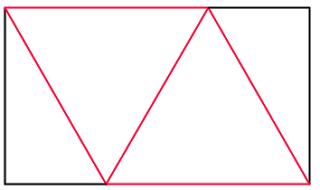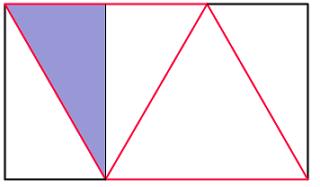Puzzles
Reverse bases again
Find three digits \(a\), \(b\) and \(c\) such that \(abc\) in base 10 is equal to \(cba\) in base 9?
Show answer & extension
Hide answer & extension
445 in base 10 is equal to 544 in base 7.
Extension
Find another pair of bases \(A\) and \(B\) so that there exist digits \(d\), \(e\) and \(f\) such that \(def\) in base \(A\) is equal to \(fed\) in base \(B\)?
Two
Find \(a\) such that \(a+(a+A)^{-1}=2\), where \(A=(a+A)^{-1}\).
ie. \(a + \frac{1}{a + \frac{1}{a + \frac{1}{a + \frac{1}{...}}}} = 2\).
Find \(b\) such that \(b+(b+B)^{\frac{1}{2}}=2\), where \(B=(b+B)^{\frac{1}{2}}\).
ie. \(b + \sqrt{b + \sqrt{b + \sqrt{b + \sqrt{...}}}} = 2\).
Find \(c\) such that \(c+(c+C)^{2}=2\), where \(C=(c+C)^{2}\).
In terms of \(k\), find \(d\) such that \(d+(d+D)^{k}=2\), where \(D=(d+D)^{k}\).
Reverse bases
Find two digits \(a\) and \(b\) such that \(ab\) in base 10 is equal to \(ba\) in base 4.
Find two digits \(c\) and \(d\) such that \(cd\) in base 10 is equal to \(dc\) in base 7.
Find two digits \(e\) and \(f\) such that \(ef\) in base 9 is equal to \(fe\) in base 5.
Show answer & extension
Hide answer & extension
If \(ab\) in base 10 is equal to \(ba\) in base 4, then \(10a+b=4b+a\).
So, \(9a=3b\).
\(a\) and \(b\) must both be less than 4, as they are digits used in base 4, so \(a=1\) and \(b=3\).
So 13 in base 10 is equal to 31 in base 4.
By the same method, we find that:
- 23 in base 10 is equal to 32 in base 7.
- 46 in base 10 is equal to 64 in base 7.
- 12 in base 9 is equal to 21 in base 5.
- 24 in base 9 is equal to 42 in base 5.
Extension
For which pairs of bases \(A\) and \(B\) can you find two digits \(g\) and \(h\) such that \(gh\) in base \(A\) is equal to \(hg\) in base \(B\)?
Ninety nine
In a 'ninety nine' shop, all items cost a number of pounds and 99 pence. Susanna spent £65.76. How many items did she buy?
Show answer & extension
Hide answer & extension
Every item bought will cause the pence in the total cost to fall by 1. So to spend £65.76, Susanna must have bought 24 items.
Extension
What is the smallest amount Susanna could spend for which we could not tell how many items she bought?
Triangle numbers
Let \(T_n\) be the \(n^\mathrm{th}\) triangle number. Find \(n\) such that: $$T_n+T_{n+1}+T_{n+2}+T_{n+3}=T_{n+4}+T_{n+5}$$
Show answer & extension
Hide answer & extension
\(T_{n} = \frac{1}{2}n(n+1)\), so:
$$T_{n}+T_{n+1} = \frac{1}{2}n(n+1) + \frac{1}{2}(n+1)(n+2)$$
$$= (n+1)^2$$
So, we are looking for \(n\) such that \((n+1)^2+(n+3)^2=(n+5)^2\). This is true when \(n=5\) (\(6^2+8^2=10^2\)).
Extension
Find \(n\) such that \(T_{n}+T_{n+1}+T_{n+1}+T_{n+2}=T_{n+2}+T_{n+3}\).
Ellipses
A piece of string 10cm long is tied to two pins 6cm apart.
The string is used to draw an ellipse. The pins are then moved 2cm further apart and a second ellipse is drawn. Which ellipse has the larger area?
Show answer & extension
Hide answer & extension
The area of an ellipse is \(\pi ab\) where \(a\) and \(b\) are the distances from the centre of the ellipse to the closest and furthest points on the ellipse.
In the first ellipse, \(a=5\mathrm{cm}\) and \(b=4\mathrm{cm}\), so the area is \(20\pi\mathrm{cm}^2\). In the second ellipse, \(a=5\mathrm{cm}\) and \(b=3\mathrm{cm}\), so the area is \(15\pi\mathrm{cm}^2\). Hence, the first ellipse has the larger area.
Extension
How far apart should the pins be placed to give the ellipse with the largest area?
Folding tube maps
Back in 2012, I posted instructions for
folding a tetrahedron from tube maps. When tube maps are used, the sides of the tetrahedron are not quite equal. What ratio would the rectangular maps need to be in to give a regular tetrahedron?
Show answer & extension
Hide answer & extension
Once the map is folded, it will look like this:
For the final tetrahedron to be regular, the red lengths must be equal. Let each red length be 2 (this will get rid of halves in the upcoming calculations). By drawing a vertical line in we can work out the width and height of the rectangle:
The width of the rectangle is 3 (one and a half red lengths). Using Pythagoras' Theorem in the blue triangle, we find that the height of the rectangle is \(\sqrt{3}\). Therefore, the ratio of the rectangle is \(\sqrt{3}:3\) or \(1:\sqrt{3}\).
Extension
If the ratio of the rectangle is \(1:a\), what is the ratio of the lengths of the sides of the tetrahedron?
x to the power of x again
Let \(y=x^{x^{x^{x^{...}}}}\) [\(x\) to the power of (\(x\) to the power of (\(x\) to the power of (\(x\) to the power of ...))) with an infinite number of \(x\)s]. What is \(\frac{dy}{dx}\)?
Show answer & extension
Hide answer & extension
\(y=x^{x^{x^{x^{...}}}}\) so \(y=x^y=e^{y\ln{x}}\).
By the chain and product rules, \(\frac{dy}{dx}=e^{y\ln{x}}(\frac{dy}{dx}\ln{x}+\frac{y}{x})\).
Rearranging, we get \(\frac{dy}{dx}=\frac{ye^{y\ln{x}}}{x(1-e^{y\ln{x}}\ln{x})}\).
This simplifies to \(\frac{dy}{dx}=\frac{x^{x^{x^{x^{...}}}}x^{x^{x^{x^{...}}}}}{x(1-x^{x^{x^{x^{...}}}}\ln{x})}\).
Extension
What would the graph of \(y=x^{x^{x^{x^{...}}}}\) look like?


